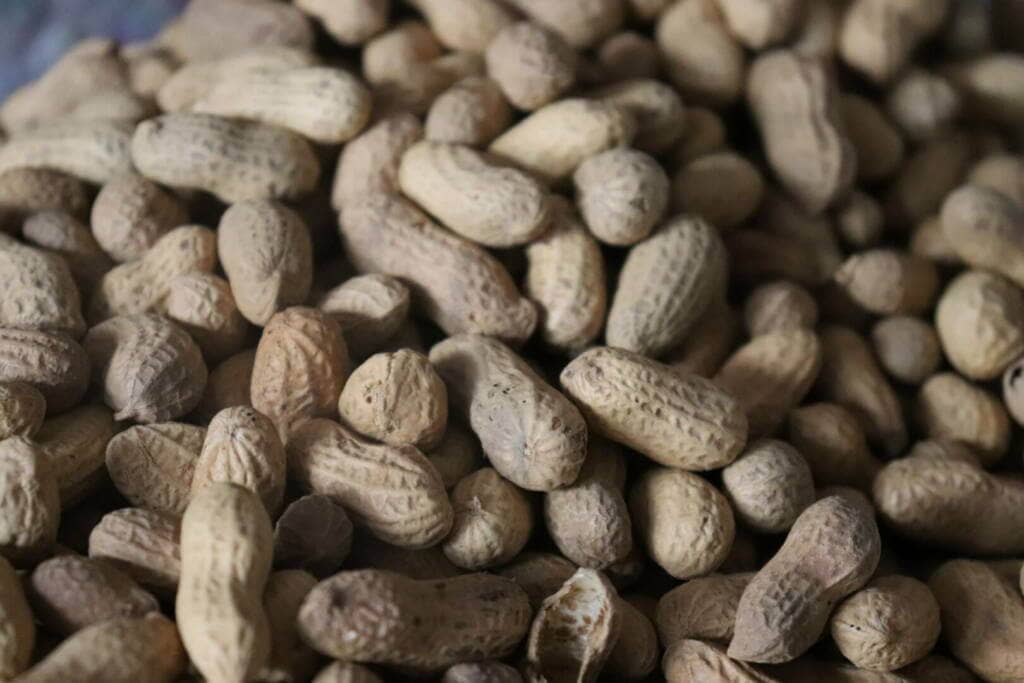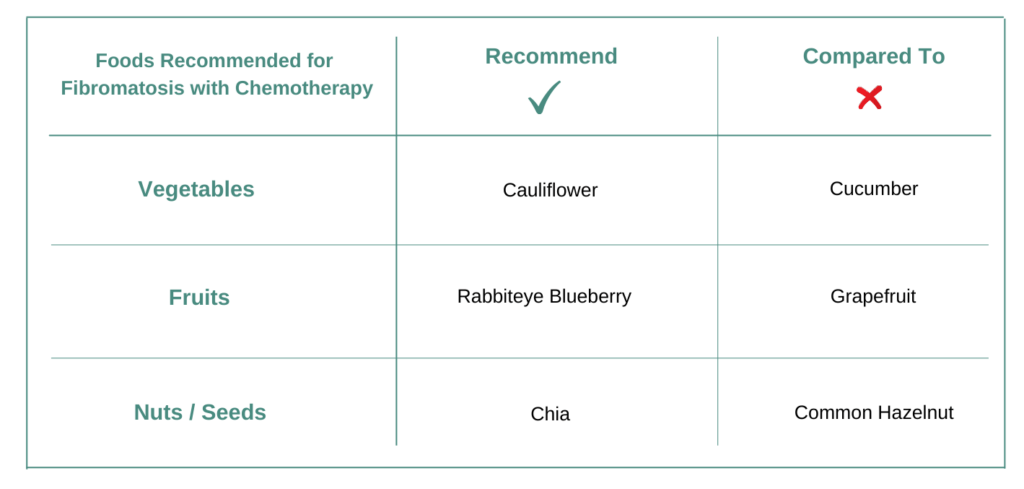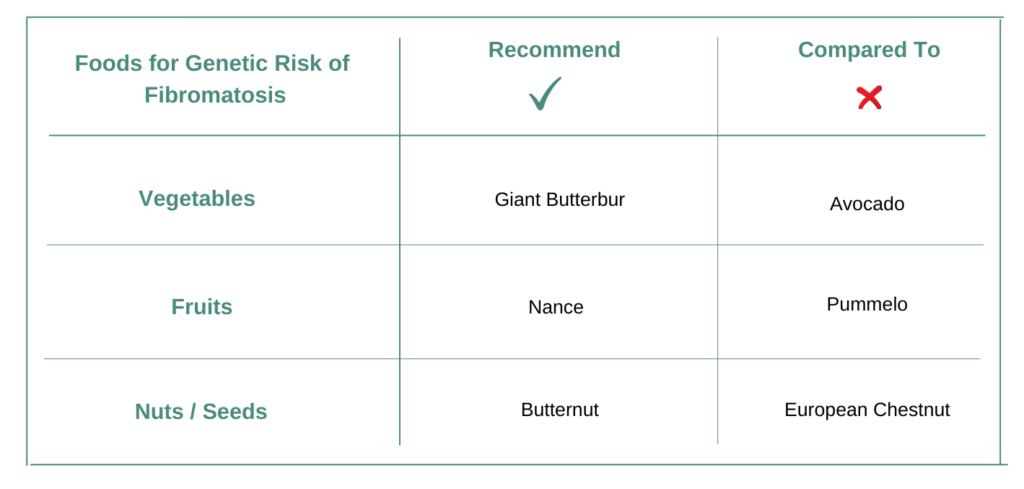Introduction
Foods for Fibromatosis should be personalized for each individual and also must adapt when cancer treatment or tumor genetic change. The personalization and adaptation must consider all the active ingredients or bioactives contained in different foods with respect to cancer tissue biology, genetics, treatments, lifestyle conditions and diet preferences. Hence while nutrition is one of the very important decisions for a cancer patient and individual at risk of cancer to make – how to choose foods to eat is not an easy task.
Fibromatosis, also called desmoid tumors, are rare, benign (noncancerous) growths that occur in the connective tissue, most often in the abdomen, arms and legs. These fibromatosis desmoid tumors do not spread to other areas of the body, but their growth can be very aggressive, and they can grow into nearby organs and structures. Symptoms of fibromatosis desmoid tumors differ based on where the tumor occur, and they can form anywhere in the body. The general symptoms may include a mass or swelling, pain, loss of function in the affected area and cramping and nausea when the desmoid tumor is in the abdomen. These fibromatosis desmoid tumors most often occur in younger adults, and rarely in children and older individuals, and tend to be more common in females. Treatment modalities for fibromatosis desmoid tumors include surgery, radiation therapy, and as a last option, chemotherapy, only for those tumors that have a rapid growth and for which surgery is not an option. Fibromatosis desmoid tumors have a good prognosis and a 5-year survival of more than 98%, but survival rates may vary depending on the size and location of the tumor and response to the treatment. Supportive care with the right nutrition (foods and supplements) can help enhance the well-being of the patient.
For Fibromatosis does it matter what vegetables, fruits, nuts, seeds one eats?
A very common nutrition question asked by cancer patients and individuals at-genetic risk of cancer is – for cancers like Fibromatosis does it matter what foods I eat and which I do not? Or if I follow a plant-based diet is that enough for cancer like Fibromatosis?
For example does it matter if vegetable Cauliflower is consumed more compared to Cucumber? Does it make any difference if fruit Grapefruit is preferred over Rabbiteye Blueberry? Also if similar choices are made for nuts/seeds like Chia over Common Hazelnut and for pulses like Moth Bean over Lima Bean. And if what I eat matters – then how does one identify foods which are recommended for Fibromatosis and is it the same answer for everyone with the same diagnosis or genetic risk?
Yes! Foods you eat matters for Fibromatosis!
Food recommendations may not be the same for everyone and can be different even for the same diagnosis and genetic risk.

All foods (vegetables, fruits, nuts, seeds, pulses, oils etc.) and nutritional supplements are made up of more than one active molecular ingredient or bio-actives in different proportions and quantities. Each active ingredient has a unique mechanism of action – which can be activation or inhibition of different biochemical pathways. Simply stated foods and supplements which are recommended are those which do not cause an increase of molecular drivers of cancer but reduce them. Else those foods should not be recommended. Foods contain multiple active ingredients – hence when evaluating foods and supplements you need to consider the impact of all active ingredients cumulatively rather than individually.
For example Grapefruit contains active ingredients Isoliquiritigenin, Phloretin, Naringenin, Delphinidin, Formononetin. And Rabbiteye Blueberry contains active ingredients Quercetin, Eugenol, Geraniol, Gallic Acid, Ferulic Acid and possibly others.
A common mistake made when deciding and choosing foods to eat for Fibromatosis – is to evaluate only selected active ingredients contained in foods and ignore the rest. Because different active ingredients contained in foods may have opposing effects on cancer drivers – you cannot cherry pick active ingredients in foods and supplements for making a nutrition decision for Fibromatosis.
YES – FOOD CHOICES MATTER FOR CANCER. NUTRITION DECISIONS MUST CONSIDER ALL ACTIVE INGREDIENTS OF FOODS.
Skills Needed for Nutrition Personalization for Fibromatosis?
Personalized nutrition for cancers like Fibromatosis consists of recommended foods / supplements; not recommended foods / supplements with example recipes which prioritize use of recommended foods. An example of personalized nutrition can be seen at this link.
Deciding which foods are recommended or not is extremely complicated, requiring expertise in Fibromatosis biology, food science, genetics, biochemistry along with good understanding of how cancer treatments work and associated vulnerabilities by which the treatments could stop being effective.
MINIMUM KNOWLEDGE EXPERTISE NEEDED FOR NUTRITION PERSONALIZATION FOR CANCER ARE: CANCER BIOLOGY, FOOD SCIENCE, CANCER TREATMENTS AND GENETICS.
Foods to Eat After Cancer Diagnosis!
No two cancers are the same. Go beyond the common nutrition guidelines for everyone and make personalized decisions about food and supplements with confidence.
Characteristics of cancers like Fibromatosis
All cancers like Fibromatosis can be characterized by a unique set of biochemical pathways – the signature pathways of Fibromatosis. Biochemical pathways like Angiogenesis, JAK-STAT Signaling, Epithelial to Mesenchymal Transition, Growth Factor Signaling are part of the signature definition of Fibromatosis. Each individual’s cancer genetics can be different and hence their specific cancer signature could be unique.
The treatments which are effective for Fibromatosis need to be cognizant of the associated signature biochemical pathways for each cancer patient and individual at genetic risk. Therefore different treatments with different mechanisms of actions are effective for different patients. Similarly and for the same reasons foods and supplements need to be personalized for each individual. Hence some foods and supplements are recommended for Fibromatosis when taking cancer treatment Radiation, and some foods and supplements are not recommended.
Sources like cBioPortal and many others provide population representative patient anonymized data from clinical trials for all cancer indications. This data consists of clinical trial study details like sample size / number of patients, age groups, gender, ethnicity, treatments, tumor site and any genetic mutations.
CTNNB1, KDR and JAK1 are the top ranked reported genes for Fibromatosis. CTNNB1 is reported in 75.0 % of the representative patients across all clinical trials. And KDR is reported in 8.3 %. The combined population patient data cover ages from to . 38.5 % of the patient data are identified as men. The Fibromatosis biology along with reported genetics together define the population represented signature biochemical pathways for this cancer. If the individual cancer tumor genetics or genes contributing to the risk are also known then that should also be used for nutrition personalization.
NUTRITION CHOICES SHOULD MATCH WITH EACH INDIVIDUAL’S CANCER SIGNATURE.
Food and Supplements for Fibromatosis
For Cancer Patients
Cancer patients on treatment or on palliative care need to make decisions on food and supplements – for the needed dietary calories, for managing any treatment side effects and also for improved cancer management. All plant-based foods are not equal and choosing and prioritizing foods which are personalized and customized to ongoing cancer treatment is important and complicated. Here are some examples providing guidelines for making nutrition decisions.
Choose Vegetable CAULIFLOWER or CUCUMBER?
Vegetable Cauliflower contains many active ingredients or bioactives such as Isoliquiritigenin, Phloretin, Delphinidin, Formononetin, Brassinin. These active ingredients manipulate various biochemical pathways like JAK-STAT Signaling, Epithelial to Mesenchymal Transition and Angiogenesis and others. Cauliflower is recommended for Fibromatosis when ongoing cancer treatment is Radiation. This is because Cauliflower modifies those biochemical pathways which have been scientifically reported to sensitize the effect of Radiation.
Some of the active ingredients or bioactives in vegetable Cucumber are Isoliquiritigenin, Phloretin, Cucurbitacin E, Delphinidin, Formononetin. These active ingredients manipulate various biochemical pathways like JAK-STAT Signaling and Angiogenesis and others. Cucumber is not recommended for Fibromatosis when ongoing cancer treatment is Radiation because it modifies those biochemical pathways which make the cancer treatment resistant or less responsive.
VEGETABLE CAULIFLOWER IS RECOMMENDED OVER CUCUMBER FOR Fibromatosis AND TREATMENT Radiation.
Choose Fruit RABBITEYE BLUEBERRY or GRAPEFRUIT?
Fruit Rabbiteye Blueberry contains many active ingredients or bioactives such as Quercetin, Eugenol, Geraniol, Gallic Acid, Ferulic Acid. These active ingredients manipulate various biochemical pathways like JAK-STAT Signaling, Epithelial to Mesenchymal Transition and Angiogenesis and others. Rabbiteye Blueberry is recommended for Fibromatosis when ongoing cancer treatment is Radiation. This is because Rabbiteye Blueberry modifies those biochemical pathways which have been scientifically reported to sensitize the effect of Radiation.
Some of the active ingredients or bioactives in fruit Grapefruit are Isoliquiritigenin, Phloretin, Naringenin, Delphinidin, Formononetin. These active ingredients manipulate various biochemical pathways like JAK-STAT Signaling and Angiogenesis and others. Grapefruit is not recommended for Fibromatosis when ongoing cancer treatment is Radiation because it modifies those biochemical pathways which make the cancer treatment resistant or less responsive.
FRUIT RABBITEYE BLUEBERRY IS RECOMMENDED OVER GRAPEFRUIT FOR Fibromatosis AND TREATMENT Radiation.
Choose Nut CHIA or COMMON HAZELNUT?
Chia contains many active ingredients or bioactives such as Isoliquiritigenin, Phloretin, Delphinidin, Formononetin, Myricetin. These active ingredients manipulate various biochemical pathways like JAK-STAT Signaling, Epithelial to Mesenchymal Transition and Angiogenesis and others. Chia is recommended for Fibromatosis when ongoing cancer treatment is Radiation. This is because Chia modifies those biochemical pathways which have been scientifically reported to sensitize the effect of Radiation.
Some of the active ingredients or bioactives in Common Hazelnut are Quercetin, Isoliquiritigenin, Phloretin, Delphinidin, Formononetin. These active ingredients manipulate various biochemical pathways like Epithelial to Mesenchymal Transition and Angiogenesis and others. Common Hazelnut is not recommended for Fibromatosis when ongoing cancer treatment is Radiation because it modifies those biochemical pathways which make the cancer treatment resistant or less responsive.
CHIA IS RECOMMENDED OVER COMMON HAZELNUT FOR Fibromatosis AND TREATMENT Radiation.

For Individuals with Genetic Risk of Cancer
The question asked by individuals who have genetic risk of Fibromatosis or familial history is “What Should I Eat Differently from Before?” and how they should choose foods and supplements to manage risks of the disease. Since for cancer risk there is nothing actionable in terms of treatment – decisions of foods and supplements become important and one of the very few actionable things which can be done. All plant-based foods are not equal and based on identified genetics and pathway signature – the choices of food and supplements should be personalized.
Choose Vegetable GIANT BUTTERBUR or AVOCADO?
Vegetable Giant Butterbur contains many active ingredients or bioactives such as Curcumin, Apigenin, Isoliquiritigenin, Lycopene, Phloretin. These active ingredients manipulate various biochemical pathways like Cell Cycle Checkpoints, NFKB Signaling, Focal Adhesion and PI3K-AKT-MTOR Signaling and others. Giant Butterbur is recommended for risk of Fibromatosis when associated genetic risk is CTNNB1. This is because Giant Butterbur increases those biochemical pathways which counteract the signature drivers of it.
Some of the active ingredients or bioactives in vegetable Avocado are Curcumin, Quercetin, Isoliquiritigenin, Vitamin D3, Phloretin. These active ingredients manipulate various biochemical pathways like Small Molecule Transport and others. Avocado is not recommended when risk of Fibromatosis when associated genetic risk is CTNNB1 because it increases the signature pathways of it.
VEGETABLE GIANT BUTTERBUR IS RECOMMENDED OVER AVOCADO FOR CTNNB1 GENETIC RISK OF CANCER.
Choose Fruit NANCE or PUMMELO?
Fruit Nance contains many active ingredients or bioactives such as Curcumin, Apigenin, Isoliquiritigenin, Phloretin, Formononetin. These active ingredients manipulate various biochemical pathways like Cell Cycle Checkpoints, NFKB Signaling, Focal Adhesion and PI3K-AKT-MTOR Signaling and others. Nance is recommended for risk of Fibromatosis when associated genetic risk is CTNNB1. This is because Nance increases those biochemical pathways which counteract the signature drivers of it.
Some of the active ingredients or bioactives in fruit Pummelo are Curcumin, Apigenin, Quercetin, Isoliquiritigenin, Lycopene. These active ingredients manipulate various biochemical pathways like WNT Beta Catenin Signaling and Epithelial to Mesenchymal Transition and others. Pummelo is not recommended when risk of Fibromatosis when associated genetic risk is CTNNB1 because it increases the signature pathways of it.
FRUIT NANCE IS RECOMMENDED OVER PUMMELO FOR CTNNB1 GENETIC RISK OF CANCER.
Choose Nut BUTTERNUT or EUROPEAN CHESTNUT?
Butternut contains many active ingredients or bioactives such as Curcumin, Apigenin, Isoliquiritigenin, Lycopene, Phloretin. These active ingredients manipulate various biochemical pathways like Cell Cycle Checkpoints, RAS-RAF Signaling, NFKB Signaling and Focal Adhesion and others. Butternut is recommended for risk of Fibromatosis when associated genetic risk is CTNNB1. This is because Butternut increases those biochemical pathways which counteract the signature drivers of it.
Some of the active ingredients or bioactives in European Chestnut are Curcumin, Apigenin, Quercetin, Ellagic Acid, Isoliquiritigenin. These active ingredients manipulate various biochemical pathways like WNT Beta Catenin Signaling and Epithelial to Mesenchymal Transition and others. European Chestnut is not recommended when risk of Fibromatosis when associated genetic risk is CTNNB1 because it increases the signature pathways of it.
BUTTERNUT IS RECOMMENDED OVER EUROPEAN CHESTNUT FOR CTNNB1 GENETIC RISK OF CANCER.

In Conclusion
Foods and Supplements chosen are important decisions for cancers like Fibromatosis. Fibromatosis patients and individuals with genetic-risk always have this question: “What foods and nutritional supplements are recommended for me and which are not?” There is a common belief which is a misconception that all plant-based foods could be beneficial or not but would not be harmful. Certain foods and supplements can interfere with cancer treatments or promote molecular pathway drivers of cancer.
There are different types of cancer indications like Fibromatosis, each with different tumor genetics with further genomic variations across each individual. Further every cancer treatment and chemotherapy has a unique mechanism of action. Each food like Cauliflower contains various bioactives in different quantities, which have an impact on different and distinct sets of biochemical pathways. The definition of personalized nutrition is individualized food recommendations for the cancer indication, treatments, genetics, lifestyle and other factors. Nutrition personalization decisions for cancer require knowledge of cancer biology, food science and an understanding of different chemotherapy treatments. Finally when there are treatment changes or new genomics is identified – the nutrition personalization needs re-evaluation.
The addon nutrition personalization solution makes the decision making easy and removes all the guesswork in answering the question, “What foods should I choose or not choose for Fibromatosis?”. The addon multi-disciplinary team includes cancer physicians, clinical scientists, software engineers and data scientists.
Personalized Nutrition for Cancer!
Cancer changes with time. Customize and modify your nutrition based on cancer indication, treatments, lifestyle, food preferences, allergies and other factors.
References
- Pan Origimed 2020
- β-Sitosterol and Gemcitabine Exhibit Synergistic Anti-pancreatic Cancer Activity by Modulating Apoptosis and Inhibiting Epithelial-Mesenchymal Transition by Deactivating Akt/GSK-3β Signaling.
- Isoliquiritigenin Inhibits Ovarian Cancer Metastasis by Reversing Epithelial-to-Mesenchymal Transition.
- Brassinin Represses Invasive Potential of Lung Carcinoma Cells through Deactivation of PI3K/Akt/mTOR Signaling Cascade.
- Vitamin C enhances epigenetic modifications induced by 5-azacytidine and cell cycle arrest in the hepatocellular carcinoma cell lines HLE and Huh7.
- Retinol decreases beta-catenin protein levels in retinoic acid-resistant colon cancer cell lines.
- Curcumin inhibits the growth via Wnt/β-catenin pathway in non-small-cell lung cancer cells.
- Ganeshan DM et al, J Comput Assist Tomogr., 2020
- https://my.clevelandclinic.org/health/diseases/22075-desmoid-tumors
- https://www.mayoclinic.org/diseases-conditions/desmoid-tumors/symptoms-causes/syc-20355083
